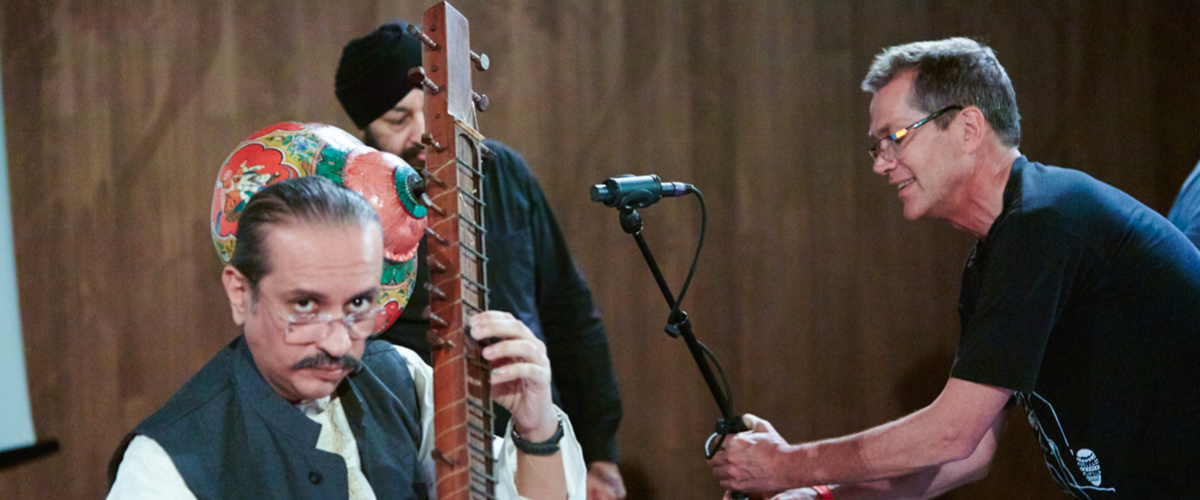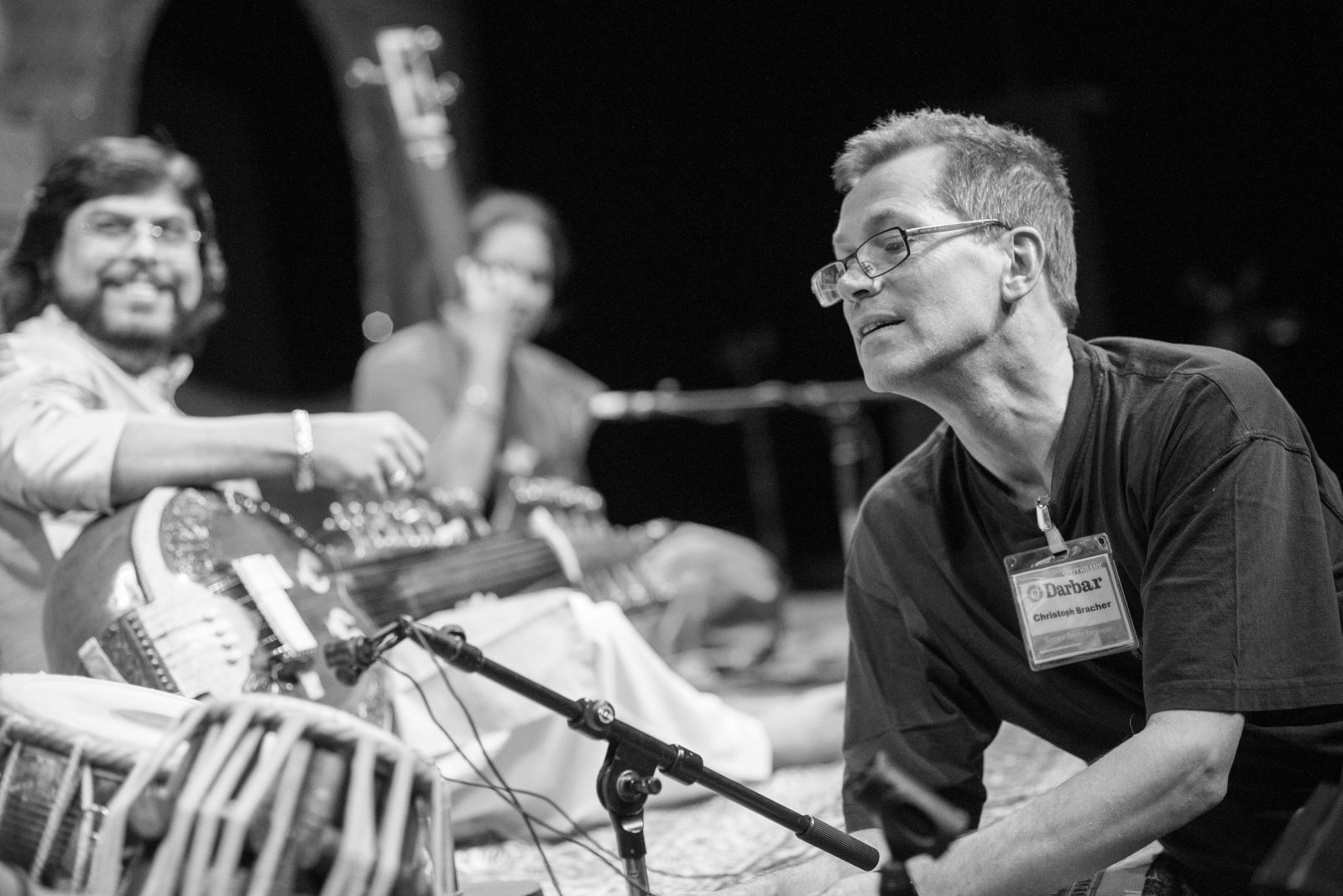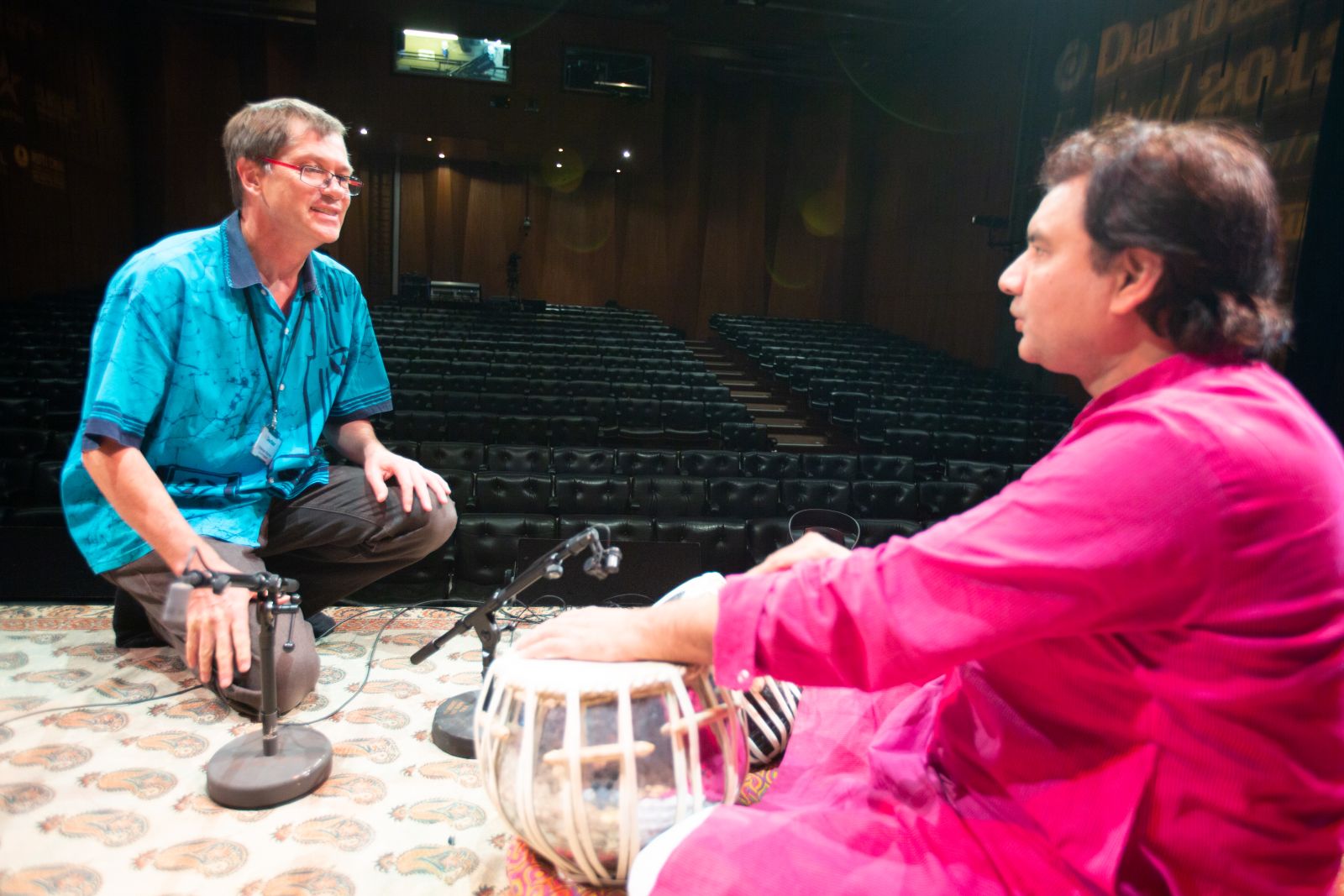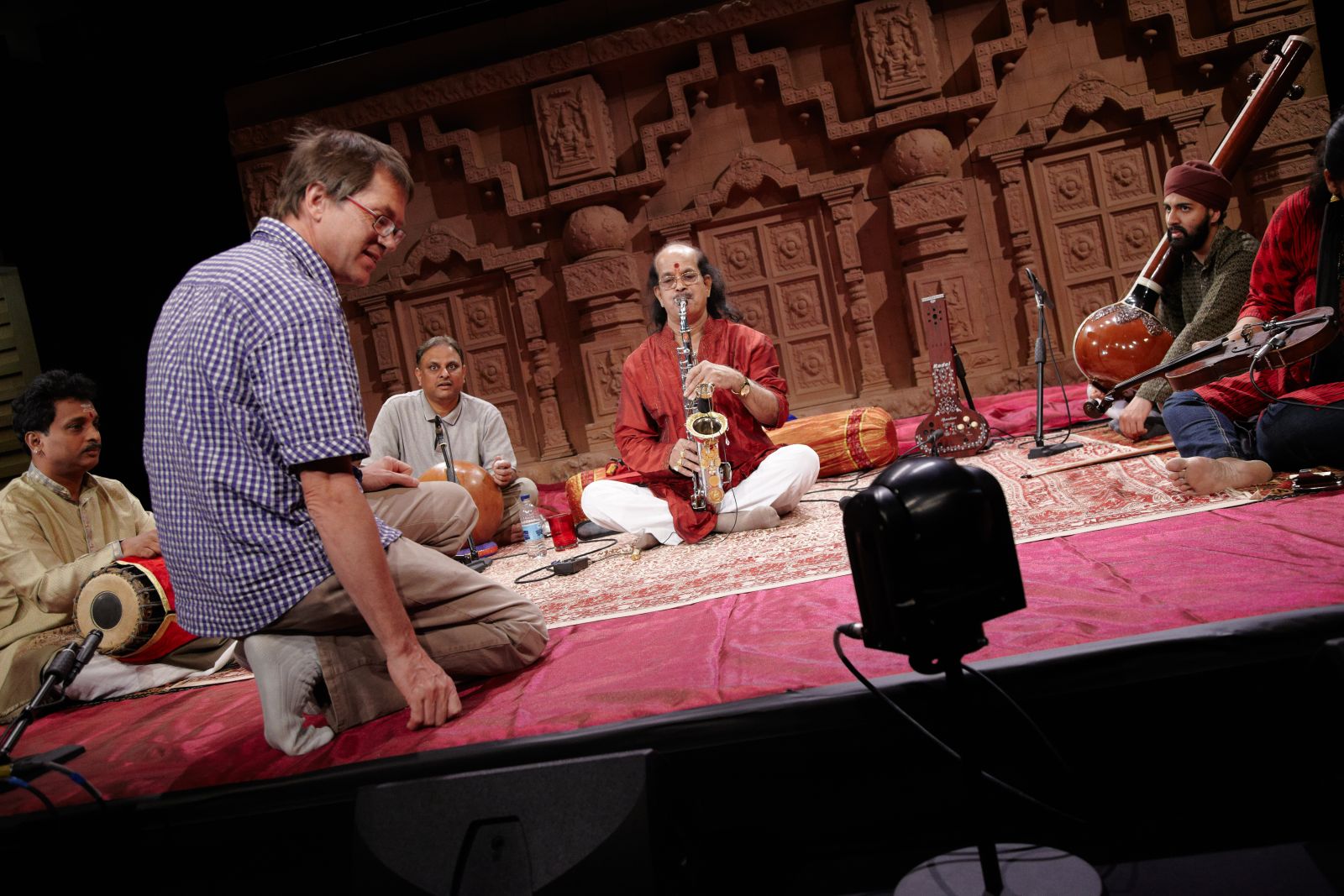

Behind the scenes with Darbar’s sound engineer Christoph Bracher
With so many moving parts in an artform driven by extempore, spontaneous performance, orchestrating an Indian classical music concert is no small feat. Maintaining the purity of the raga and the notes is even harder. Once the metaphorical veil is lifted – as so much of Indian classical music takes place without a definitive ‘backstage’ – the audience is enchanted by the musicians, artists, instruments and grandiose backdrop itself. But amid this mesmerising stagescape of centuries-old tradition, there’s also cutting-edge technological wonder.
How does Darbar successfully reimagine and recontextualise Indian classical music for our times, and our geography? Because essentially, the music played in courts (and darbars) of yore was intended for an intimate audience – not necessarily the largest and most prestigious venues in England. Maintaining the idiosyncrasies of each instrument while amplifying the reach and sound is a veritable science.
And when the person in charge of sound is also entrenched in balancing the nuanced interplay of different instruments, it is elevated to become an artform.
“I’d say I’ve been with Darbar even before the inception of Darbar Festival. Darbar started with the funeral of Mr. Virdee’s father,” says sound engineer Christoph Bracher, the man behind the sound of Darbar. Bracher’s is a role that artistic director, Sandeep Virdee, OBE, says is
“...nothing short of magic. He is truly responsible for reimagining Indian classical music globally.”
Bracher’s story is steeped in rich cultural understanding. Before he began working with Indian classical music, he worked with Iranian classical instruments as well. He has played a pivotal role for Sachal Studios Orchestra jazz, designed state of the art studios, provided final mastering for iconic albums and been a sound engineer at The Conference Room and Redfort Studios.
To say he’s left an indelible mark would be an understatement.
Bracher’s balancing act
But perhaps his deepest and most paradigm-altering contribution comes with Darbar. “Let me put it this way,” he explains, “There’s always a difference between being in a small room in front of a few musicians and sitting a long way away from them...because you don’t have the intimacy. So the idea [is to] kind of give them [the audience] the same emotion...but from a distance.”
That’s easier said than done, however, and Brachar continues: “That usually means that the sound has to be larger than life in a way.” And what the mic picks up may not always be what the instrument sounds like in earnest. It follows, then, that a great deal of fine-tuning is required to find that elusive ‘sweet-spot.’

“Basically, a microphone needs to be fairly true,” Bracher explains. But with a live sound system, monitors and the need for the sound to be somewhat larger than life, the various competing needs, demands and considerations may mean, “The sound gets dirtied by the fact that it’s amplified.” To use an analogy, he says the amplification mechanism can, “...throw all sorts of mud back into the system. You want a nice, natural and slightly bigger than natural sound. Yet at the same time, it’s live...So it’s really about finding the right balance.”
There’s even the detail of what looks better on screen and the aesthetic positioning and beauty of the mic. Competing needs can also manifest between light and sound. In the early years of Darbar, for instance, the first venue was a cinema. When the lights went on, there would be a buzz in the system, he shares. Similarly, there are often small lamps with built-in fans in front of the stage, and the noise often overlays even the quietest moments of a performance. “It’s not a massive conflict though,” Bracher concedes.
Ultimately, though, it really boils down to the instrument. “Some instruments, you find, don’t really want a highly sensitive microphone,” he points out. A harmonium, for instance, might generate many ‘clacking’ sounds if the mic picks up so much.
Similarly, one of Bracher’s toughest deliverables is maintaining the balancing act between every instrument being ‘the greatest’ versus the beauty of the whole ensemble and how various components fit into each other to create a harmonious whole.
Miking the West. Miking the East
The difference between Indian and Western classical music performance, explains Bracher, is that Western classical music instruments are often designed for the sound to be carried over long distances, whereas Indian classical music is essentially ‘court music’ originally performed in a small, enclosed space. A better comparison to Indian classical music in the West, he says, is chamber music. But with an orchestra or classical opera, the art form – and the performance space – is designed to allow the sound and fill up a large area. “Different genres require different approaches,” Bracher sums up, as do different instruments.
The shehnai or dholak, for instance, are designed to be loud and project over long distances, unlike many other Indian instruments with a somewhat smaller sound. The most finicky Indian instrument to mic and capture in a way that does justice to the music, says Bracher, is the whole family of stringed instruments (for instance, the sitar).
Another important distinction is live tuning in front of the audience, a unique feature of Indian classical performances. When the artists arrive on stage, the mics are often off, and then gradually turned on as they tune, explains Bracher. “Often times, the audience listens along because in a way, they’re also tuning in to the performance,” he says, though some instrumentalists, such as violinists, may be tuning even once the ‘actual’ performance begins.
One of his pet peeves, shares Bracher, is that, “Modern sound systems are designed to be incredibly clean at a very loud volume, [whereas] ‘old school’ sound engineers would want to push the sound system to the point where it’s made its own sound.”
“A lot of concerts that I go to nowadays,” Bracher continues, “are way too loud for me. Instead of subtle and lovely things, the noise [is] such that people [can’t] even talk while it happens…where it really should be so that they all have to hold their breath to make sure they don’t miss anything.”
Bracher judiciously selects microphones for percussion instruments, vocals and other purposes. Schoeps, Neumann and DPA are some of his go-to favourites, he says. “Over the years, we’ve acquired microphones that we find work well,” he says. Inspiration and experience have come in many forms, even from the BBC while working with the tabla.
With such deep experience, familiarity and hard-won insights through trial and error, Bracher says now, “It’s more like you look at an instrument and you have your standards of what you think will work well.” Occasionally, however, there are modifications, artist preferences and requests that he accommodates. It’s a labour of love – one where the learning is immersive and the trajectory never really ends.
Beautiful soundscapes
For Bracher, though, it’s worth it. “For me, Indian classical music is something of a meditation.” It elevates one's spirit, he says, and the goal is to convey that sort of transcendent feeling.
Yet, Bracher can only do so much. And he’s not afraid of telling it like it is: “It also very much depends on the quality of the artist. Not every artist can create a sophisticated enough soundscape that that [transcendent meditation] happens.”
The sound itself is crucial, and the success of the sound engineer and the artist is symbiotically intertwined – holistic – just like the artform of Indian classical music itself.
When the soundscape itself is compromised, a lot of the sound engineer’s job is to ‘repair’ the sound and make it reflect what was envisioned. But
“With the quality of artists at Darbar, the soundscape they’re creating is already so beautiful…so it’s more about embellishing it and making the colours more vivid,” Bracher says.
When asked what percentage of a performance can be ruined by a sound engineer, his response gets straight to the point:
“Ooof. Everything."
“If you can’t hear them…then everything’s ruined. The first row possibly has good fun, but no-one else!” he continues. The reverse is also true: to a great degree, you can elevate a performance with effective sound engineering, says Bracher. The system itself, though, needs to be clean, he maintains, as otherwise, it modifies the sound and has feedback at certain frequencies. It’s also possible that the resonance of a sound system or room can work better with certain keys, but only the most adept of artists is able to fluidly and instantaneously make that switch during a performance.
There is actually a great deal of making game time decisions, musical understanding and exercising one’s best judgement involved. An expert sound engineer will have the wisdom to know that not every sound coming from the stage needs to be ‘fixed’ Bracher explains. In other words, not every noise is a problem, and some of it is intentional.
One common mistake of the inexperienced sound engineer is that he or she may try to identify the resonances and drones the artist is actually intentionally producing and wrongly classify them as ‘technical problems’ that need to be removed, when in reality, these are sounds that serve as the foundation for the piece.
For example, shares Bracher, a musician playing heavily on the root note of the raag or a tabla player having a very powerful ‘baaya’ or right hand to hold a sustaining note might be misunderstood by an inexperienced sound engineer as feedback.
“If you don’t understand the aesthetic, then obviously you can make silly mistakes,” he concludes.

So what does it really mean to mic an artist, and mic him/her well?
“To mic someone means you look at someone, the sound they generate and the space or environment they’re in at that moment. Then you have to try to establish the best method of capturing what they do…at the same time, you also want to make them happy with what they hear from themselves, because you always need monitoring. It means choosing the right microphone for the job, basically.”
It also means choosing the right stand for the job, he continues. The stands must be inconspicuous, Bracher says, and usually the stage resonates and microphones at Darbar Festival are kept in shock sleeves to prevent them from catching the extra force or sound that goes into the stage ground. The base might have a heavy rubber underneath to absorb shock and prevent that extra sound from being picked up.
That’s also where the decades of experience of a sound engineer comes into play, as he or she alone will have the wisdom to distinguish between sounds that are full of character and a part of the art form, versus those that shouldn’t be picked up.
For those interested in the field, Bracher says there are two approaches: the scientific approach, and those who may start out helping the band carry the speakers and learn as they go.
However, there’s one non-negotiable thing all sound engineers need: ears. “They need a lot of patience and listening to the artist; certainly when you do live sounds, the most important thing is you need to make the artist happy,” he smiles. A good sound engineer, says Bracher, needs to be listening all the time. This includes:
(i) listening to the artist,
(ii) listening to what they sound like (the music),
(iii) and of course, listening to what the audience expects as well.

Continuing with the importance of ensuring the artist’s comfort and happiness on stage – integral to the overall performance, especially in such an extempore format as Indian classical music – Bracher says that understanding nuances and cadences of spoken language or bodily gestures is also of paramount importance. An Indian classical musician, for instance, may not use English in the same way as a native British speaker and keep asking for the sound to be ‘louder’ whereas really, he or she may mean they want to hear themselves more clearly. An artist may also be accustomed to working with a very different quality sound system at home, and the introduction to a new system can be unnerving and disorienting initially.
Miking an artist, then, is to do justice to their music, to their life history, to their heritage and their craft. To be a friend, therapist, life coach and ally, an enabler with the artists’, audience’s and the performance’s best interest at heart.
100%
With his rich and illustrious history, both with Darbar and elsewhere, Bracher has succeeded in capturing the soundscapes he speaks of with utmost grace – almost like a dreamcatcher. He’s distilled, projected, nurtured and amplified some of the most beautiful sounds to have graced the human ear since primordial times. He’s done so in a manner that spans not just the distance from the stage to the last row of the audience, but the distance from centuries-old India to contemporary London.
And that, right there, is magic.
He’s pleased with the extent Darbar Festival goes to in order to pay homage to the heritage, history and authenticity of the art form.
Still, it’s hard to replicate 100% authenticity when an art form is taken out of its geographical home, explains Bracher.
Of course, a concert hall in London may not capture the 31C temperatures, humidity, hundreds of cups of chai, an open square and an evening breeze – all elements of the land where Indian classical music is most performed.
“But can it still be a worthwhile experience? Yes. Definitely.”
100%.
The lifeblood of all Indian classical music, whether Hindustani (North Indian) or Carnatic (South Indian), is the...
Read More 
Darbar Fringe Festival is Leicester's summer music festival which brings urban, contemporary and classical genres...
Read More 
The Jaipur-Atrauli vocalist talks ragas from the past, rhythms as warrior-heroes, and the limits of approaching music...
Read More 
The beginner's guide to Indian classical music. Whether you’re completely new to raga music or just need a refresher, we’ve put together this brief overview of all things raga music to help you feel at ease when visiting one of our concerts or watch our videos on our YouTube or our Darbar Concert Hall.
Keep up to date with the latest news, events, music and musings across our social channels
For hundreds more clips and shorts, vist our YT page here 